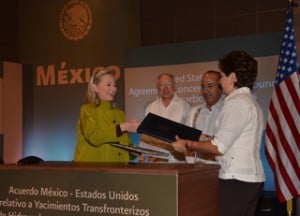 Before I head off to New Haven for Convergencias 2012, hosted by the Yale Mexican Students Association, I will reflect on 5 themes that define the inner-workings of America’s relationship with our Southern neighbor:
Before I head off to New Haven for Convergencias 2012, hosted by the Yale Mexican Students Association, I will reflect on 5 themes that define the inner-workings of America’s relationship with our Southern neighbor:
1. Trade between these two neighbors is symbiotic. In 2010, mutual trade reached $362 billion. As I discussed in my Great Decisions review post, 40% of the content of Mexican exports to the U.S. are American inputs.
The number of Mexicans leaving for the U.S. declined an estimated 60% between 2006 and 2010 (Pew Hispanic Center). However, as the U.S. economy continues its slow growth, so will Mexican commerce with the U.S. The population explosion of Hispanics in the U.S. will happen regardless – Hispanics are now about 15% of the population, and will be near 30% by 2050. Around two-thirds will be Mexican-American.
U.S. firms will need to look to customers in Mexico who look to customers in the U.S.
2. Mutual trade is not only natural, but beneficial both ways. Mexico and the U.S. do as much business in 1 month as Mexico does with the entire EU in a year, and the benefits to Mexico are well recognized. Over 80% of Mexico’s exports, $217 billion, go to the U.S., and 90% of Mexico’s tourists come from the U.S. Mexican companies that export pay salaries 37% higher than those that do not.
However, as the U.S. Administration looks to shore up exports, Mexico will be an attractive market. In 2010, U.S. exports to Mexico increased 27% to $163 billion after a fall in the recession year of 2008. Having Mexico nearby also helps U.S. motorists – Mexico is our second-largest petroleum supplier after Canada. (Source: US State Department, EIA)
3. The Transboundary Hydrocarbons Agreement, signed Monday by Secretary of State Clinton and Mexican Foreign Minister Patricia Espinosa, could be the right recipe for PEMEX. PEMEX is long in need of investment and expertise from corporate partners, and this agreement could provide the political cover. The Agreement provides incentives (though not yet public) for joint development of offshore reserves by PEMEX and U.S. oil companies. The Agreement also opens up 1.5 million acres in the Gulf’s Western Gap for exploration.
4. The Merida Initiative is one of the U.S.’s most sophisticated bi-lateral security agreements, and allows the U.S. to directly influence internal security operations in a foreign state. However, this is evidently in the interest of the U.S., Mexico, and others – at the Mexican Federal Police Academy in San Luis Potosí, over 4,500 officers have been trained by officials from the U.S., Colombia, Spain, Canada, and the Czech Republic. Perhaps this cooperation can be expanded in the fight against international drug trafficking, for which the U.S. has delivered $465 million in equipment and aid. While Operation Fast and Furious was bungled by the U.S., Merida appears to be generating progress appreciated by all.
5. Trust me, American politicians’ desire to ignore immigration will end. Not due to will, but due to demographics. Mitt Romney’s campaign website states on immigration that “A porous border allows illegal immigrants to enter the United States, violent cartel members and terrorists possibly among them.” President Obama’s website does not highlight immigration as an issue at all, only referring to benefits that Latino Americans will receive from the American Jobs Act. This negligence from senior leaders begets controversial policies such as Arizona’s infamous immigration law.
If America’s leaders do not promulgate common sense immigration reform, it will be dictated to them by a future enormous block of Hispanic voters.